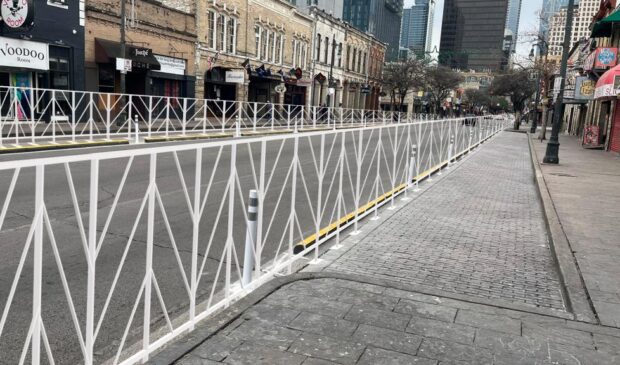City reports fewer crimes, stable crowds in Sixth Street pilot
Monday, May 5, 2025 by
Chad Swiatecki Data from the city’s efforts to revitalize the Sixth Street Entertainment District show reductions in violent crime and public safety incidents, according to a new memo summarizing the results of a pilot program launched late last year.
A recent memo from Development Services Department leadership to City Council reported a modest, but notable, decline in serious incidents along Sixth Street, and stable pedestrian activity following the reintroduction of vehicle traffic during weekend nights. The pilot also won positive feedback from business owners and stakeholders regarding outdoor seating expansions and atmosphere improvements.
The pilot program, initiated this past fall, reopened portions of Sixth Street to vehicle traffic on weekends, introduced designated ride-hailing pickup zones, expanded outdoor seating opportunities for bars and restaurants and supported a series of temporary public space activations. Temporary barricades were used to manage pedestrian flow and vehicle access. The city developed a data collection and reporting process to track safety, transportation and business activity. Staff noted that while early indicators are encouraging, continued evaluation and adjustments are necessary to refine strategies ahead of long-term infrastructure and policy changes.
Austin Police Department data cited in the memo supports the findings, showing that use-of-force incidents on Sixth Street dropped by 50 percent between January 1 and February 11, 2025, compared to the same period the year prior. Arrests in the immediate area declined by 34 percent, and overall crimes against persons dropped by 21 percent. Officers also reported a significant decrease in fights and disturbances in the area.
The traffic management plan was identified as a key factor in the positive results, along with increased officer visibility, changes in leadership within the downtown police sector, enhanced traffic enforcement and greater collaboration with bar owners to address chronic nuisance issues.
Parking and transportation coordination featured prominently in the pilot program, with the city working with private property owners and the Downtown Austin Alliance to create new valet strategies and improve rideshare circulation. The expansion of the Affordable Parking Program for late-night downtown workers and musicians was explored, alongside plans for a potential district-wide parking model intended to reduce congestion and enhance accessibility. The memo acknowledged the need for better enforcement of parking and loading rules and continued evaluation of pedestrian safety measures around loading zones and alleyways.
Staff worked closely with the Austin Police Department, the Austin Fire Department and Austin-Travis County EMS to monitor safety concerns during peak times, while the Public Assembly Code Enforcement (PACE) team expanded its role in ensuring compliance with occupancy, fire safety, and alcohol service regulations. City leaders are evaluating staffing needs and funding required to make the PACE team’s expanded presence a permanent, year-round function.
Work continues on recommendations related to an entertainment license for businesses serving alcohol after midnight and a potential Vacant Property Registration Program to address persistent vacant and underutilized structures along the corridor.
A City Council resolution adopted in April noted the need to improve infrastructure, enhance public safety strategies and coordinate transportation improvements as part of a broader Sixth Street safety and revitalization plan. That resolution also directed staff to continue gathering detailed safety, transportation, and economic data during the pilot’s duration, and to bring forward additional recommendations for mid-term and long-term improvements, including cost estimates, timelines, and potential funding sources.
Next steps include continued monitoring and data collection over the coming months, additional stakeholder engagement with relevant boards and commissions, and the development of a mid-term plan to guide further changes to the street’s layout, business regulations, and public space design. City staff expect to present a more detailed set of recommendations to City Council later this year, with quarterly updates and formal progress reports continuing through the end of 2025.
The Austin Monitor’s work is made possible by donations from the community. Though our reporting covers donors from time to time, we are careful to keep business and editorial efforts separate while maintaining transparency. A complete list of donors is available here, and our code of ethics is explained here.
You're a community leader
And we’re honored you look to us for serious, in-depth news. You know a strong community needs local and dedicated watchdog reporting. We’re here for you and that won’t change. Now will you take the powerful next step and support our nonprofit news organization?




